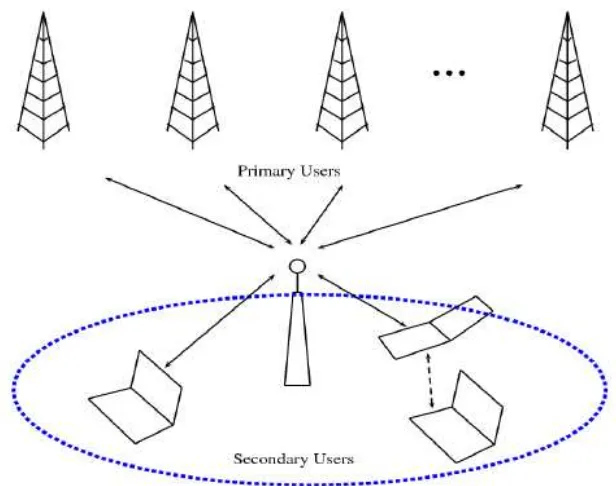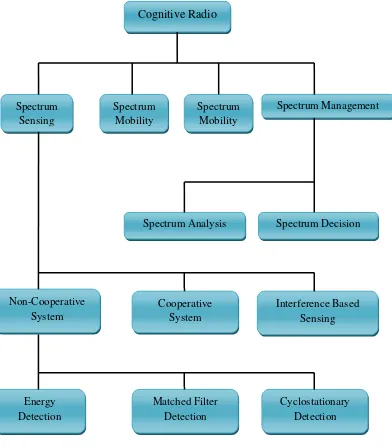v
ACKNOWLEDGEMENT
Foremost, all praise to ALLAH for entire incredible gift endowed upon me and for giving me the health and strength to complete this ‘Projek Sarjana Muda’.
First of all, I would like to give a million thanks and appreciation to my supervisor, Pn Mas Haslinda binti Mohamad for her advice, criticism and also her guidance in order to complete my project. Besides, she also provided good ideas and opinions on my project. The final project year has given me some experience that I can use for the future.
vi
ABSTRACT
vii
ABSTRAK
viii
CONTENTS
CHAPTER DESCRIPTION
PAGES
PROJECTTOPIC i
PSMIIREPORTSTATUSVERIFICATIONFORM ii DECLARATION iii
SUPERVISOR DECLARATION iv
ACKNOWLEDGEMENT v
ABSTRACT vi
ABSTRAK vii
CONTENTS viii
LIST OF TABLES xi
LIST OF FIGURES xii
LIST OF APPENDICES xv
I INTRODUCTION 1.1 PROJECT BACKGROUND 1 1.2 PROBLEM STATEMENT 3
ix
II LITERATURE REVIEW
2.1 COGNITIVE RADIO 5 2.1.1 Matched Filter Detection 11 2.1.2 Cyclostationary Detection 13 2.2 ENERGY DETECTOR 16 2.3 BINARY PHASE SHIFT KEYING (BPSK) 19 2.4 FOURIER SERIES 21 2.5 SUMMARY 22
III METHODOLOGY
3.1 PROJECT PLANNING 23 3.2 PROJECT METHODOLOGY WORKFLOW 24 3.3 GENERATED BPSK MODULATION 25 3.4 GENERATED AN ENERGY DETECTOR 27 3.4 SUMMARY 29
IV RESULTS AND DISCUSSIONS
4.1 SIMULATION RESULTS & ANALYSIS 30 4.1.1 Simulation Results 30 4.1.2 Results of Changed Parameters 37 4.2 SUMMARY 56
V CONCLUSION AND RECOMMENDATION
x
REFERENCES 59
APPENDICE A 61
xi
LIST OF TABLES
NO TITLE
PAGE
4.1 Analysis performance of when SNR and N changed 55
xii
LIST OF FIGURES
NO TITLE
PAGES
2.1 Primary Users and Secondary usUers 5 2.2 Spectrum Structure of The Cognitive Radio 6
2.3 Main Functions of Cognitive Radio 7 2.4 Block Diagram of Matched Filter Detection 10 2.5 Block Diagram of Cyclostationary Detection 12
2.6 Various Sensing Methods of Complexity and Sensing Accuracy 13 2.7 Block Diagram of An Energy Detector 15
2.8 Block Diagram Consists of Modulated and Demodulated BPSK
Signal 18
2.9 Periodic Continuous of Fourier Series 21
3.1 Workflow Description 23
3.2 Block Diagram of Modulated BPSK Signal 25
3.3 Output Equation of BPSK Modulation in Coding 26
3.4 Energy Detector Techniques 27
4.1 Stages of Energy Detector 31
4.2 Output at Stage A (Signal of BPSK Modulation when N=8) 31
4.3 Output at Stage B (Band Pass Filter) 32
xiii
4.5 Output from Stage E (Probability of Detection and Probability of
Missed Detection) 34
4.6(a) The Probability of Detection, 35
4.6(b) The Probability of Missed Detection, 36
4.7(a) Output of and when SNR=-10dB 37 4.7(b) Output of and when SNR=-20dB 38
4.8(a) The Probability of Detection, when SNR=-10dB 39
4.8(b) The Probability of Detection, when SNR=-20dB 39
4.9(a) The Probability of Missed Detection, when SNR=-10dB 40
4.9(b) The Probability of Missed Detection, when SNR=-20dB 40
4.10(a) The Threshold Value when SNR=-10dB 41
4.10(b) The Threshold Value when SNR=-20dB 41
4.11(a) The Output Waveform of BPSK Modulation Signal and Result Signal
when N=16 42
4.11(b) Output Waveform of Band Pass Filter 42
4.11(c) Output Waveform of Squaring Device 43
4.12(a) Output of and when SNR=-10dB 43
4.12(b) Output of and when SNR=-20dB 44
4.13(a) The Probability of Detection, when SNR=-10dB 45
4.13(b) The Probability of Detection, when SNR=-20dB 45
4.14(a) The Probability of Missed Detection, when SNR=-10dB 46
4.14(b) The Probability of Missed Detection, when SNR=-20dB 46
xiv
4.15(b) The Threshold Value when SNR=-20dB 47
4.16(a) The Output Waveform of BPSK Modulation Signal and Result Signal
when N=32 48
4.16(b) Output Waveform of Band Pass Filter 49
4.16(c) Output Waveform of Squaring Device 49
4.17(a) Output of and when SNR=-10dB 50
4.17(b) Output of and when SNR=-20dB 50
4.18(a) The Probability of Detection, when SNR=-10dB 51
4.18(b) The Probability of Detection, when SNR=-20dB 52
4.19(a) The Probability of Missed Detection, when SNR=-10dB 52
4.19(b) The Probability of Missed Detection, when SNR=-20dB 53
4.20(a) The Threshold Value when SNR=-10dB 54
xv
LIST OF APPENDICES
NO TITLE
PAGES
1
CHAPTER 1
INTRODUCTION
This chapter covers about the project background mainly to synopsis of the project, objective and scope project, and problem statement.
1.1 Project Background
2
This situation has resulted in increasing demand for spectrum and frequency bands become much more crowded, especially in densely populated urban centers. Various solutions have been made to overcome this situation. Among these is the sharing of spectrum, spectrum licensing for large companies and so on. Although a variety of possible solutions but still not able to overcome this problem. This situation has led to other solutions of cognitive radio technology. Cognitive radio are not the best solutions, but this is the other way to solved the situation.
What is cognitive radio? Cognitive radio is a network technology that automatically able to find and detected a vacant radio frequency. The cognitive radio has a capability using real time sensing of the radio environment, spectrum holes or white spaces that were unused at a specific time or location can be determined. By allowing secondary networks to share the spectrum with the primary networks, cognitive radio is expected to greatly improve the spectrum utilization.
One of the main functions of cognitive radio is spectrum sensing, where used transmitter detection to detect the unused spectrum. Transmitter detection consists of spectrum sensing. Spectrum sensing required by detecting unused spectrum and sharing it without harmful interference to other users. There are three spectrums sensing techniques that can be used in transmitter detection, such as energy detector, matched filter, and cyclostationary.
3
1.2 Problem Statement
Nowadays, the demand for wireless spectrum increased as the number of users who use wireless devices in communication systems increased. The current policies of spectrum block result in inefficiency of spectrum usage. In some block, the spectra are saturated, whereas other bands are underused. The improvement will need a flexible yet regulated use of spectrum band.
The spectrum becomes limited because of the lack of frequency resource in the VHF and UHF spectrum bands, where many users use the spectrum at the same time. Due to the increasing demand, therefore the existing spectrum is unable to meet the needs of users. To overcome this problem, one techniques are required, so that it can be used to sense or identify the unlicensed spectrum. Cognitive radio is a better ways to overcome this problem.
1.3 Project Objectives
The objectives of this project are:
(i) To study spectrum sensing techniques in cognitive radio. (ii) To generate a BPSK signal by using MATLAB software.
(iii) To develop spectrum sensing algorithm using energy detector techniques by using MATLAB software.
4
1.4 Project Scopes
For every design that is being done, it has to have limitations. This is to ensure the scope of study is not too wide. The work in the project is limited to the following elements:
(i) This project only focuses on MATLAB software which is used to make simulation and analyze the result.
(ii) Generate BPSK modulation waveform that will act as the input data for spectrum sensing.
5
CHAPTER 2
LITERATURE REVIEW
This chapter contains the literature review theoretical concept that applied in this project. It contains the information gathering of the project in order to complete the whole project. The main source is Cognitive Radio book and other sources are related journal.
2.1 Cognitive Radio
6
[image:21.595.173.481.212.455.2]Cognitive radio is a radio which can sense its environment and has the capability to adapt some of its features, such as carrier frequency, modulation, and transmission bandwidth and transmission power allowing dynamic reuse of the available spectrum [2]. With the rapid deployment of various wireless systems, the limited radio spectrum is becoming increasingly crowded. On the other hand, it is evident that most of the allocated spectrum experience low utilization.
Figure 2.1: Primary Users and Secondary Users.
In wireless communication systems, cognitive radio consists of two categories. The two categories are the primary user (PU) and secondary user (SU) [6]. Based on the Figure 2.1, show that the primary user and the secondary user. The primary users are the licensed users where the users will be given the priority to use the frequency. While a secondary user is unlicensed users, where compare to the primary user, secondary user are not given the priority to use the frequency.
7
[image:22.595.145.516.145.335.2]the cognitive radio (CR) technology can be an enhancement of the efficiency of spectrum allocations by adopting dynamic spectrum resource management [12].
Figure 2.2: Spectrum Structure of The Cognitive Radio [3].
Several main functions of cognitive radio, which consists spectrum sensing, power control, and spectrum management [1]. Spectrum sensing is an important requirement of the cognitive radio network in order to sense or detect empty spectrum. Spectrum sensing detects the presence of signals in the frequency spectrum.
8
Figure 2.3: Main Functions of Cognitive Radio. Cognitive Radio Spectrum Sensing Spectrum Mobility Spectrum Management Non-Cooperative System Cooperative System Interference Based Sensing Spectrum Analysis Spectrum Decision
9
In spectrum sensing, there are some issues and challenges that need to be considered in spectrum sensing, in order to make spectrum sensing in cognitive radio as a better solution to overcome the problems of lack of frequencies. Among these are noise uncertainty, channel uncertainty, and detecting interference limit [2].
In wireless communications networks, the problem of channel uncertainty arises where there are some uncertainties at the received signal strength where caused by the channel disappearing (fading) or shadowing that maybe are wrong explained that the primary system is placed out of the secondary user’s interference scope as the main primary signal, where could be experiencing a deep fade or being deeply shadowed by obstacles [4].
Therefore, cognitive radios have to be extra sensitive to discriminate a faded or shadowed main primary signal from a white space. Each uncertainty in the received power of the primary signal translates into a higher detection sensitivity requirement. Moreover, the possibility of a single cognitive radio that depends on the local sensing where the increased sensitivity is not possible to achieve. Therefore, cooperative sensing are required to handle these issues where needed to allocate locale measurements and select the occupancy state on a licensed band.
In the noise uncertainty, to find the accurate sense of primary signal will be determined with the minimum SNR as the following given:
(1)
Where,
N = Noise power,
= Primary user of transmitting power, D = Secondary user of interference range,
R = Maximum distance between primary transmitter and corresponding receiver.

![Figure 2.2: Spectrum Structure of The Cognitive Radio [3].](https://thumb-ap.123doks.com/thumbv2/123dok/545908.63882/22.595.145.516.145.335/figure-spectrum-structure-cognitive-radio.webp)
